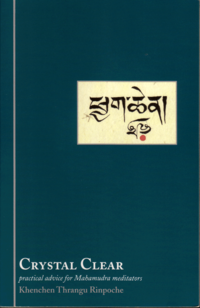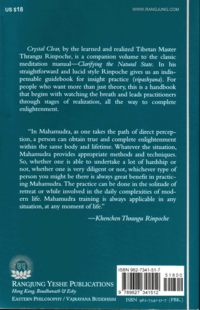Crystal Clear
 |
 |
Title[edit]
Crystal Clear
practical advice for meditators
Khenchen Thrangu Rinpoche
Publication Data[edit]
- Khenchen Thrangu Rinpoche, (b. 1933).
- Translated from the Tibetan by Erik Pema Kunsang.
- Edited by Michael Tweed.
- Title: Crystal Clear: Practical Advice for Meditators
- ISBN 962-7341-51-1
1. Crystal Clear: Helpful Advice on Mahamudra. 2. Vajrayana philosophy—Buddhism. 3. Buddhism—Tibet. I. Title. An oral commentary on: Tibetan titles: phyag rgya chen po'i khrid yig chen mo gnyug ma'i de nyid gsal ba English title: Clarifying the Natural State, Dakpo Tashi Namgyal (dvags po bkra shis rnam rgyal), (1512-1587). First edition 2003.
Contents[edit]
- preface 9
- introduction 13
- pure motivation 13
- background 15
- Clarifying the Natural State 15
- The Buddha’s Enlightenment and Teaching 17
- The Special Quality of Mahamudra 19
- part one: preliminary steps of guidance 24
- General Preliminaries 24
- Specific Preliminaries 25
- part two: the main part of the meditation stages 29
- shamatha with attributes 29
- Posture 29
- The Nature of Mind and the Purpose of Shamatha 34
- Supported Shamatha 35
- Unsupported Shamatha With Breathing Practice 38
- Unsupported Shamatha Without Breathing Practice 41
- Hindrances—Agitation and Dullness 42
- shamatha without attributes 43
- Tightening and Loosening 43
- The Threefold Freely Resting 45
- Importance of Shamatha 45
- vipashyana 47
- What is Vipashyana? 47
- The Paths of Reasoning and Direct Perception 48
- Establishing the Identity of Mind and the Perceptions 53
- Establishing the Identity of Mind—the Basis 55
- Establishing the Identity of Thoughts and Perceptions—the Expression 58
- clearing up uncertainties about basis and expression 63
- Resolving that Thoughts and Emotions are Mind 63
- Resolving That Perceptions Are Mind 72
- Investigating the Calm and the Moving Mind 74
- Resolving That All Experience Is Nonarising 76
- steps of pointing-out instruction 79
- Pointing Out of the Innate 79
- Pointing Out Innate Mind-Essence 80
- Pointing Out the Innate in Thinking 87
- Pointing Out the Innate in Perception 89
- the flawed and the flawless meditation practice 91
- Mistakes and Faulty Meditation 92
- Flawless Meditation Practice 97
- part three: subsequent ways to continue the training 102
- general reasons for meditation training 102
- special training without separating meditation and postmeditation 105
- cutting through hindrances, sidetracks and strayings 110
- The Straying with Regard to the Nature of Knowables 110
- Straying with Regard to the Path 111
- Straying with Regard to the Remedy 112
- Straying with Regard to Generalization 113
- sidetracks 113
- enhancement by transcending into nonarising 115
- Time for Transcending 115
- Investigating Thoughts and Perceptions 117
- Investigating the Meditation and the Meditating Mind 118
- The Actual Transcending into Nonarising Openness 119
- Mingling Meditation and Postmeditation, Day and Night 119
- developing strength by utilizing the conducts 121
- The Time for Utilizing and the Conducts 121
- Utilizing Thoughts 123
- Utilizing Emotions 125
- Utilizing Gods and Demons 127
- Utilizing Suffering 128
- Utilizing Sickness 130
- Utilizing the Death Process 131
- signs of realization 133
- The Four Schools and the Eight Consciousnesses 133
- how realization arises and the enhancement practices 140
- The Various Ways Realization Arises 141
- One-Pointedness and its Enhancement 143
- Bad Influences and Unfavorable Circumstances 145
- Simplicity and its Enhancement 147
- One Taste and its Enhancement 150
- Nonmeditation and its Enhancement 152
- part four: the way to traverse the paths and stages through meditation training 155
- comparing the four yogas to the paths and stages 155
- postscript 163
- glossary of texts, people and technical terms 166
- further suggested reading 173
- short biography of khenchen thrangu rinpoche 175
Preface[edit]
“There is a little text that is quite concise and focuses on how to actually practice Mahamudra.” These were the words the venerable Khenchen Thrangu Rinpoche used in the spring of 1998 when announcing his choice of topic to the participants at the annual Namo Buddha Seminar in Boudhanath, Nepal.
It turned out to be Clarifying the Natural State [Nyugmey Denyi Salwa]. Dakpo Tashi Namgyal’s classic meditation manual is unique in its simple language and practical, systematic approach, taking meditators from their initial attempt to watch the breath, through their first glimpse of realization, and all the way to buddhahood.
Day by day during the talks, Rinpoche’s outstanding talent for making complex topics simple and high-flying concepts understandable, deeply touched the listeners and inspired them to feel that experience and realization might not lie out of reach. It was almost taken as a given that his talks would find their way into edited transcripts. In fact, Gloria Jones—Rinpoche’s intrepid secretary over many years—surprised me by announcing that “Erik is translating and publishing both the root text and Rinpoche’s commentary.”
Rinpoche decided to use the same text again in 1999, and I felt reluctant to rush headlong into describing levels of realization I don’t have, when more clarification was fortuitously forced on me by circumstances. Thrangu Rinpoche also urged me to translate Dakpo Tashi Namgyal’s precious guidance manual and emphasized including the Tibetan script. “It will prove useful,” he added.
In the interim between the two courses, I was able to complete a working draft of the text. In the ensuing years while bringing this project to closure, I was amazed by both the author’s elucidative abilities, as well as by Thrangu Rinpoche’s skillful brilliance. While reviewing the transcripts, to my amazement, I noticed that Rinpoche didn’t repeat anything from the first year to the next. On the contrary, whatever needed clarification from the first set of teachings, he spontaneously expanded upon in the second set. Crystal Clear offers the result of Rinpoche’s incredible erudition.
Michael Tweed carefully and adeptly assembled Crystal Clear from transcripts of the two sets of talks. During the editing phase we corresponded regularly to settle questions, and I am extremely pleased with the outcome. As usual, my wife Marcia Binder Schmidt complemented the editing and supervised all stages of production. Again, my good friend Larry Mermelstein lent his expertise with useful suggestions.
For help in facilitating this process, I would like to express my gratitude to Gloria for fanning the flames of endeavor as well as ‘nurturing the garden’ of financial support, and to the benefactors who include Patrick Sweeney and the Ojai Foundation, Leo Duse from Italy, David Tuffield in England, Quentin English and Michael Knuhtsen, a fellow Dane. Thanks are also due to Gene Kudirka and Yeshe Palmo for transcribing several tapes, and to the proofreaders Daniel Kaufer and Garth Copenhaver.
Despite our being in this dark age, it is amazing that such a combination of auspicious circumstances can come about. Firstly, that the wonderful root text, Clarifying the Natural State, exists. Secondly, a sublime and compassionate teacher, Thrangu Rinpoche, who agreed to teach it not only once but twice in such a clear and precise way. Thirdly, that a group of Dharma friends could dedicate themselves to engaging in and completing this work in such a harmonious and inspiring way. In one voice we join to offer this to the fortunate practitioners of Mahamudra. May each and every one of you attain the dharmakaya throne of Nonmeditation.
—Erik Pema Kunsang
Nangkyi Gompa Hermitage, Nagi Gompa